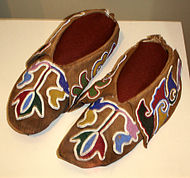
The Oklahoma History Center (OHC) is the history museum of the state of Oklahoma. Located on an 18-acre (7.3 ha) plot across the street from the Governor's mansion at 800 Nazih Zuhdi Drive in Oklahoma City, the current museum opened in 2005 and is operated by the Oklahoma Historical Society (OHS). It focuses on the history of Oklahoma.
Galleries and exhibits
The museum contains several galleries. The Inasmuch Foundation Gallery focuses on culture and the arts; cultural diversity; images of Oklahoma; sports; voice; radio and television; vacuum tubes; and Wild West shows. The ONEOK Gallery contains exhibits and presentations aimed at representing all 39 American Indian tribes currently associated with Oklahoma, describing the modern-day Indian experience as a bridge between the past and the present. The exhibits include artifacts, tribal music, photographic images, Indian art, and oral histories from the Indian tribes of Oklahoma.
The Kerr-McGee Gallery includes items from an 1830s riverboat recently excavated from the Red River, examples of Oklahoma's entrepreneurial history, and a 3-D reconstruction of an oil derrick. It also includes exhibits and sections on the African American experience; business; military matters; natural resources; the oil and gas industry; people and pathways; and transportation.
The Noble Foundation Gallery sections include education; farming and ranching; fashions; government and politics; kitchens; the Dust Bowl; land runs; law and order; urban frontiers; and weather.
The Gaylord Special Exhibit Gallery contains the Skylab 4 command module and various artifacts related to Oklahomans in space, including personal items and flight suits worn by Gordon Cooper, Fred Haise, John Herrington, Shannon Lucid, and Stuart Roosa. Two Moon rocks, one from Apollo 11 and one from Apollo 17, are also displayed.
Special events
Each year, the Oklahoma History Center hosts the Oklahoma State Level History Day Competition, the second part of a three-stage (district, state, and national) competition called National History Day. Middle- and high school students can enter documentaries, historical papers, websites, exhibit boards, or performances on a topic that the students choose that relate to each year's theme. Students' projects are judged and advance to the national competition if they place first or second in their category.
Gallery
-
 Arapaho leggings and moccasins, ca. 1910
Arapaho leggings and moccasins, ca. 1910
-
 Otoe-Missouria beaded moccasins, ca. 1880
Otoe-Missouria beaded moccasins, ca. 1880
-
 Shawnee Native American Church altar cloth
Shawnee Native American Church altar cloth
-
 Standard Oil tank truck
Standard Oil tank truck
-
 Turner Turnpike display
Turner Turnpike display
-
 Early color TV camera, WKY-TV
Early color TV camera, WKY-TV
-
 Fountain on OHS ground using native stones
Fountain on OHS ground using native stones
References
- "About the Oklahoma History Center". www.okhistory.org. Retrieved 10 July 2022.
- Hampton, Deon (21 December 2009). "Moon rock hunt ends in state". Tulsa World. Retrieved 10 July 2022.
- "Oklahoma History National History Day | Oklahoma History Center". www.okhistory.org. Oklahoma Historical Society. Retrieved 10 July 2022.
External links
- Official website
- Oklahoma Historical Society
- TravelOK.com: Oklahoma History Center - info, photos, and video — official travel and tourism website for the State of Oklahoma.
35°29′38″N 97°30′00″W / 35.4940°N 97.4999°W / 35.4940; -97.4999
| Museums in the Oklahoma City Metro | |
|---|---|
| Oklahoma City | |
| Norman | |
| Shawnee | |
| U.S. state history museums | |||||||
|---|---|---|---|---|---|---|---|
| Northeast |
| ||||||
| Midwest |
| ||||||
| South |
| ||||||
| West |
| ||||||